Report on Business Organizations: Types, Environment, and Analysis
VerifiedAdded on 2021/01/02
|16
|5158
|472
Report
AI Summary
This report provides a comprehensive analysis of business organizations, examining their types, sizes, and scopes, with a focus on Aston Martin, Oxfam, and NGOs. It explores the interrelation between different organizational departments and their functions. The report delves into the positive and negative impacts of macro-environmental factors, and conducts a SWOT analysis to assess strengths, weaknesses, opportunities, and threats. It also investigates the interplay between internal strengths and weaknesses and the external environmental factors affecting business operations. The introduction outlines the objectives of analyzing business profitability, and the conclusion synthesizes the key findings regarding the impact of market forces on business performance and strategic planning.
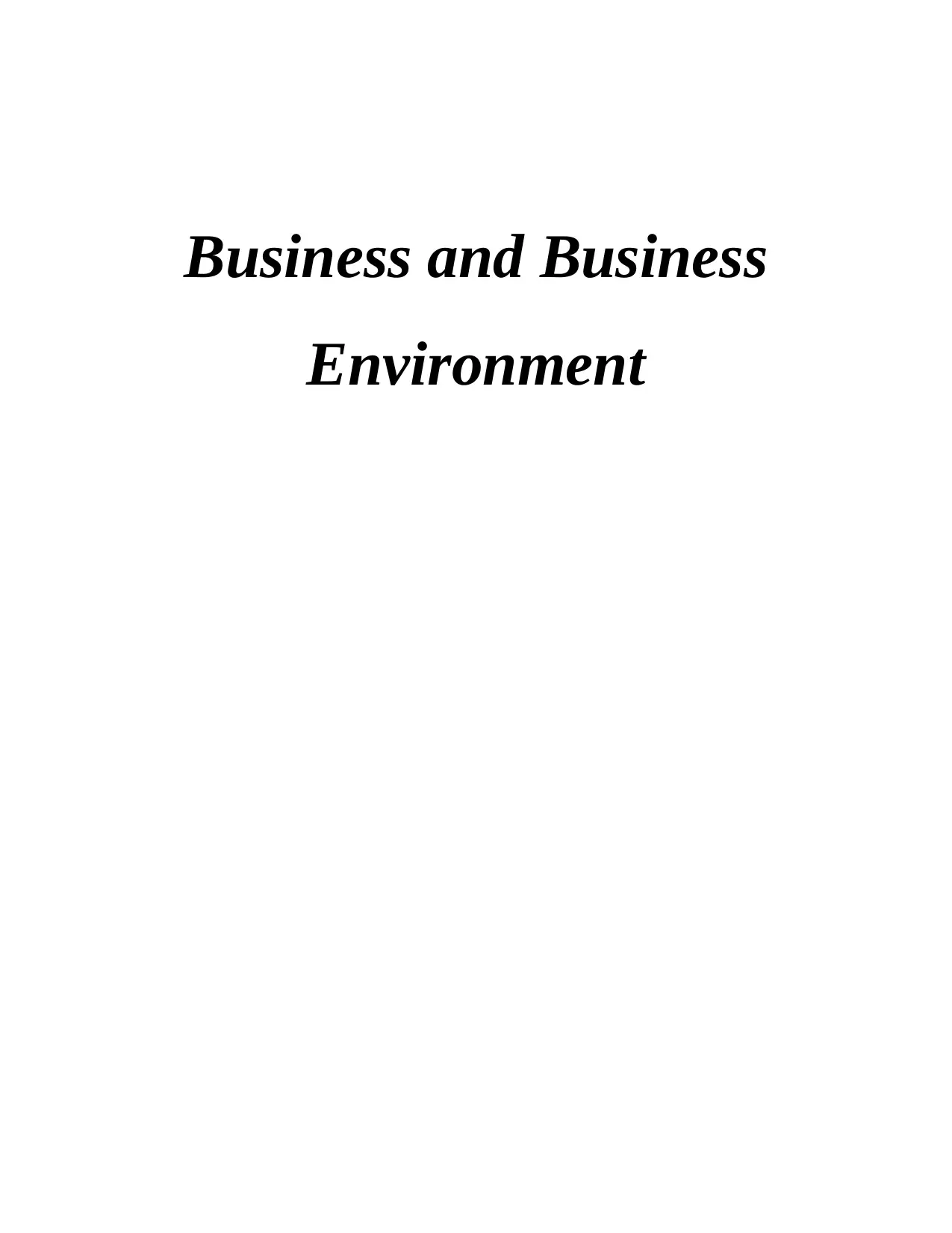
Business and Business
Environment
Environment
Paraphrase This Document
Need a fresh take? Get an instant paraphrase of this document with our AI Paraphraser
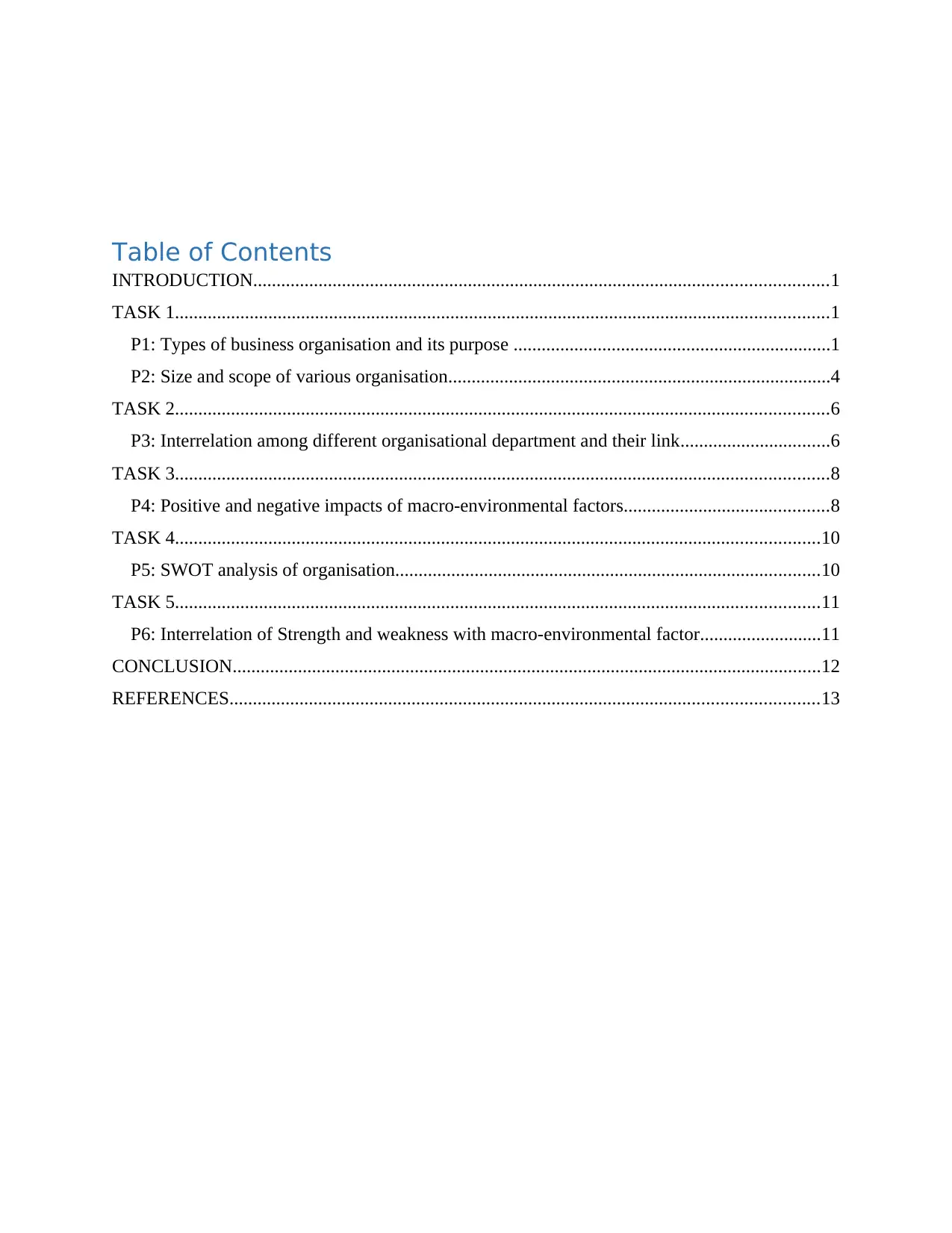
Table of Contents
INTRODUCTION...........................................................................................................................1
TASK 1............................................................................................................................................1
P1: Types of business organisation and its purpose ....................................................................1
P2: Size and scope of various organisation..................................................................................4
TASK 2............................................................................................................................................6
P3: Interrelation among different organisational department and their link................................6
TASK 3............................................................................................................................................8
P4: Positive and negative impacts of macro-environmental factors............................................8
TASK 4..........................................................................................................................................10
P5: SWOT analysis of organisation...........................................................................................10
TASK 5..........................................................................................................................................11
P6: Interrelation of Strength and weakness with macro-environmental factor..........................11
CONCLUSION..............................................................................................................................12
REFERENCES..............................................................................................................................13
INTRODUCTION...........................................................................................................................1
TASK 1............................................................................................................................................1
P1: Types of business organisation and its purpose ....................................................................1
P2: Size and scope of various organisation..................................................................................4
TASK 2............................................................................................................................................6
P3: Interrelation among different organisational department and their link................................6
TASK 3............................................................................................................................................8
P4: Positive and negative impacts of macro-environmental factors............................................8
TASK 4..........................................................................................................................................10
P5: SWOT analysis of organisation...........................................................................................10
TASK 5..........................................................................................................................................11
P6: Interrelation of Strength and weakness with macro-environmental factor..........................11
CONCLUSION..............................................................................................................................12
REFERENCES..............................................................................................................................13

⊘ This is a preview!⊘
Do you want full access?
Subscribe today to unlock all pages.

Trusted by 1+ million students worldwide
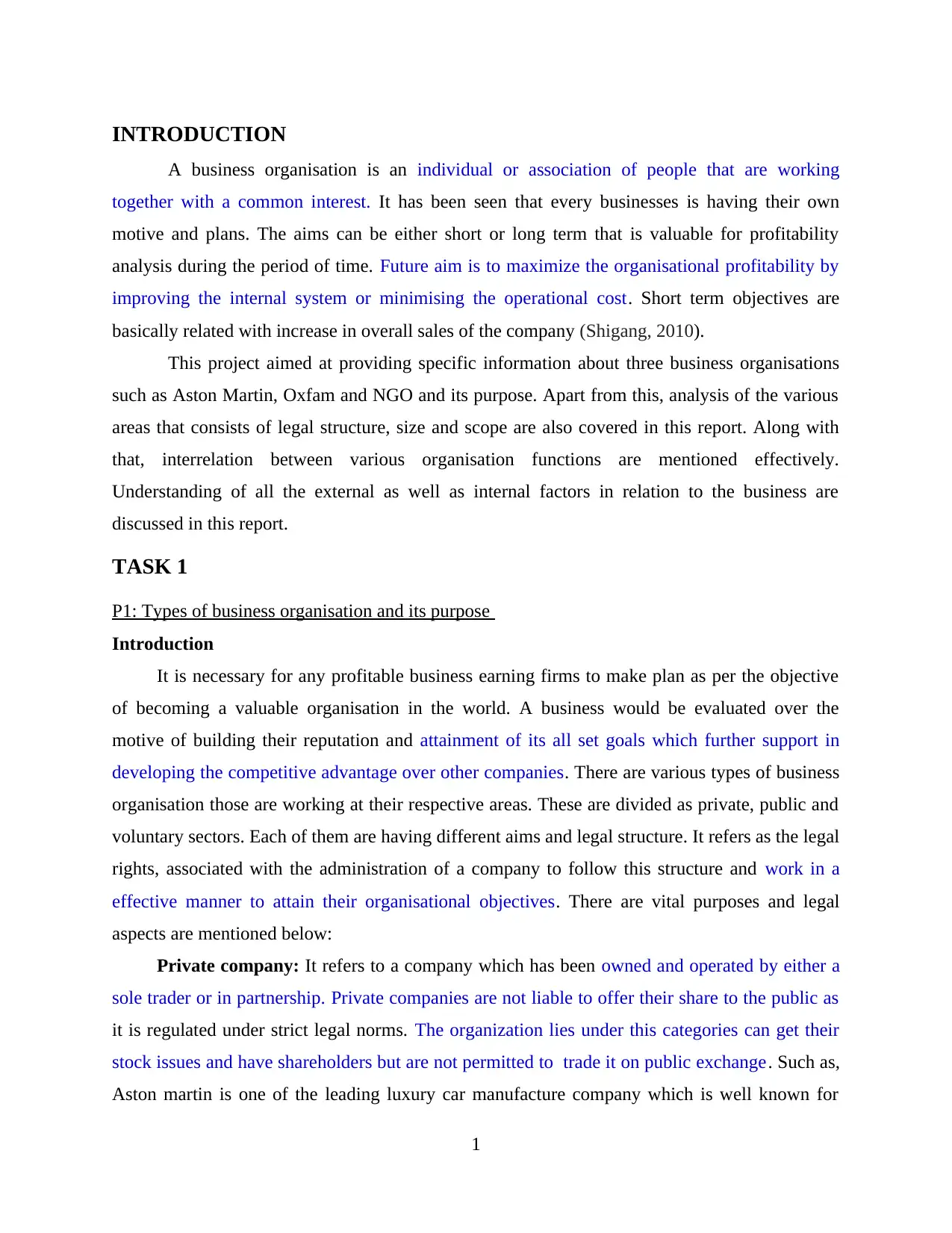
INTRODUCTION
A business organisation is an individual or association of people that are working
together with a common interest. It has been seen that every businesses is having their own
motive and plans. The aims can be either short or long term that is valuable for profitability
analysis during the period of time. Future aim is to maximize the organisational profitability by
improving the internal system or minimising the operational cost. Short term objectives are
basically related with increase in overall sales of the company (Shigang, 2010).
This project aimed at providing specific information about three business organisations
such as Aston Martin, Oxfam and NGO and its purpose. Apart from this, analysis of the various
areas that consists of legal structure, size and scope are also covered in this report. Along with
that, interrelation between various organisation functions are mentioned effectively.
Understanding of all the external as well as internal factors in relation to the business are
discussed in this report.
TASK 1
P1: Types of business organisation and its purpose
Introduction
It is necessary for any profitable business earning firms to make plan as per the objective
of becoming a valuable organisation in the world. A business would be evaluated over the
motive of building their reputation and attainment of its all set goals which further support in
developing the competitive advantage over other companies. There are various types of business
organisation those are working at their respective areas. These are divided as private, public and
voluntary sectors. Each of them are having different aims and legal structure. It refers as the legal
rights, associated with the administration of a company to follow this structure and work in a
effective manner to attain their organisational objectives. There are vital purposes and legal
aspects are mentioned below:
Private company: It refers to a company which has been owned and operated by either a
sole trader or in partnership. Private companies are not liable to offer their share to the public as
it is regulated under strict legal norms. The organization lies under this categories can get their
stock issues and have shareholders but are not permitted to trade it on public exchange. Such as,
Aston martin is one of the leading luxury car manufacture company which is well known for
1
A business organisation is an individual or association of people that are working
together with a common interest. It has been seen that every businesses is having their own
motive and plans. The aims can be either short or long term that is valuable for profitability
analysis during the period of time. Future aim is to maximize the organisational profitability by
improving the internal system or minimising the operational cost. Short term objectives are
basically related with increase in overall sales of the company (Shigang, 2010).
This project aimed at providing specific information about three business organisations
such as Aston Martin, Oxfam and NGO and its purpose. Apart from this, analysis of the various
areas that consists of legal structure, size and scope are also covered in this report. Along with
that, interrelation between various organisation functions are mentioned effectively.
Understanding of all the external as well as internal factors in relation to the business are
discussed in this report.
TASK 1
P1: Types of business organisation and its purpose
Introduction
It is necessary for any profitable business earning firms to make plan as per the objective
of becoming a valuable organisation in the world. A business would be evaluated over the
motive of building their reputation and attainment of its all set goals which further support in
developing the competitive advantage over other companies. There are various types of business
organisation those are working at their respective areas. These are divided as private, public and
voluntary sectors. Each of them are having different aims and legal structure. It refers as the legal
rights, associated with the administration of a company to follow this structure and work in a
effective manner to attain their organisational objectives. There are vital purposes and legal
aspects are mentioned below:
Private company: It refers to a company which has been owned and operated by either a
sole trader or in partnership. Private companies are not liable to offer their share to the public as
it is regulated under strict legal norms. The organization lies under this categories can get their
stock issues and have shareholders but are not permitted to trade it on public exchange. Such as,
Aston martin is one of the leading luxury car manufacture company which is well known for
1
Paraphrase This Document
Need a fresh take? Get an instant paraphrase of this document with our AI Paraphraser
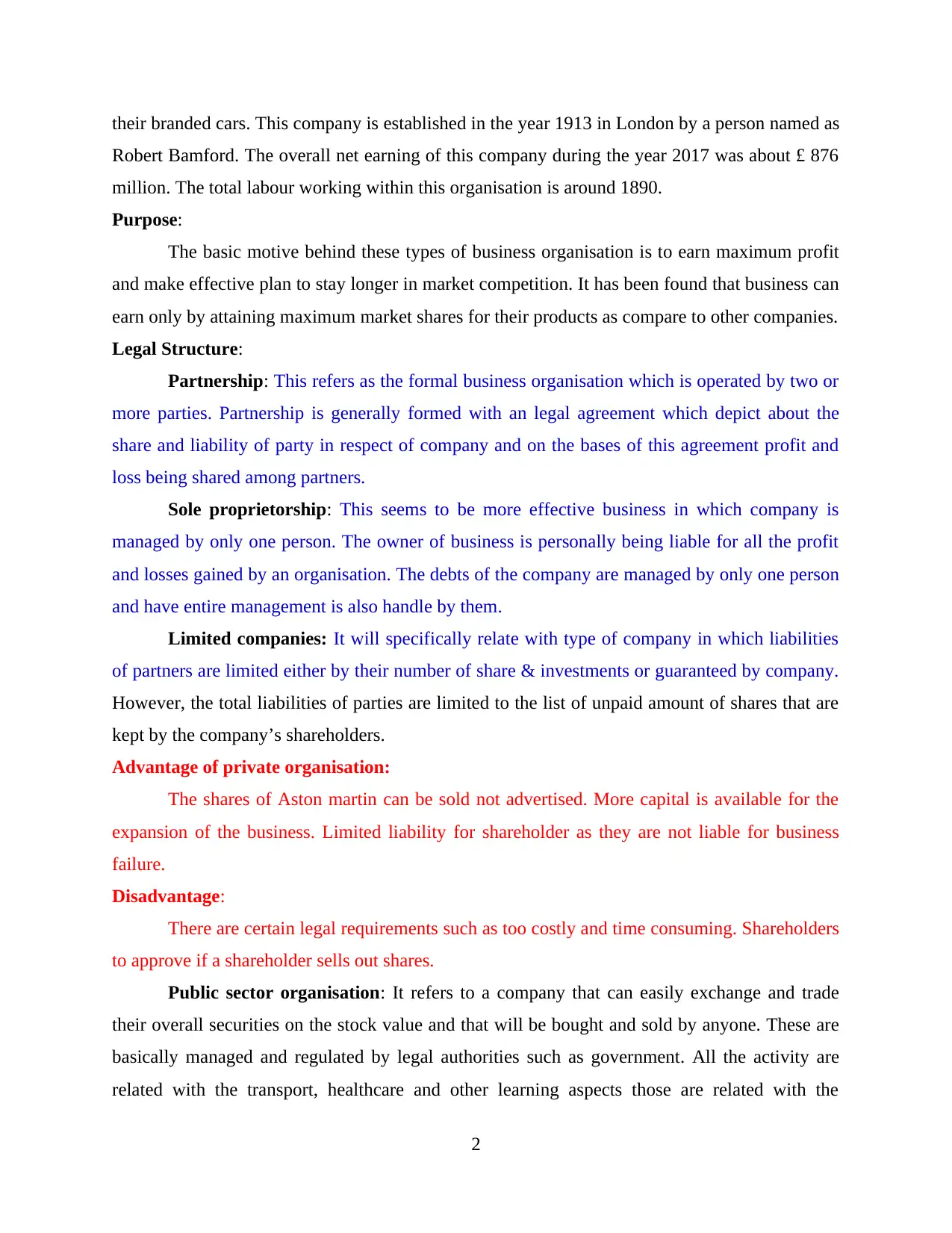
their branded cars. This company is established in the year 1913 in London by a person named as
Robert Bamford. The overall net earning of this company during the year 2017 was about £ 876
million. The total labour working within this organisation is around 1890.
Purpose:
The basic motive behind these types of business organisation is to earn maximum profit
and make effective plan to stay longer in market competition. It has been found that business can
earn only by attaining maximum market shares for their products as compare to other companies.
Legal Structure:
Partnership: This refers as the formal business organisation which is operated by two or
more parties. Partnership is generally formed with an legal agreement which depict about the
share and liability of party in respect of company and on the bases of this agreement profit and
loss being shared among partners.
Sole proprietorship: This seems to be more effective business in which company is
managed by only one person. The owner of business is personally being liable for all the profit
and losses gained by an organisation. The debts of the company are managed by only one person
and have entire management is also handle by them.
Limited companies: It will specifically relate with type of company in which liabilities
of partners are limited either by their number of share & investments or guaranteed by company.
However, the total liabilities of parties are limited to the list of unpaid amount of shares that are
kept by the company’s shareholders.
Advantage of private organisation:
The shares of Aston martin can be sold not advertised. More capital is available for the
expansion of the business. Limited liability for shareholder as they are not liable for business
failure.
Disadvantage:
There are certain legal requirements such as too costly and time consuming. Shareholders
to approve if a shareholder sells out shares.
Public sector organisation: It refers to a company that can easily exchange and trade
their overall securities on the stock value and that will be bought and sold by anyone. These are
basically managed and regulated by legal authorities such as government. All the activity are
related with the transport, healthcare and other learning aspects those are related with the
2
Robert Bamford. The overall net earning of this company during the year 2017 was about £ 876
million. The total labour working within this organisation is around 1890.
Purpose:
The basic motive behind these types of business organisation is to earn maximum profit
and make effective plan to stay longer in market competition. It has been found that business can
earn only by attaining maximum market shares for their products as compare to other companies.
Legal Structure:
Partnership: This refers as the formal business organisation which is operated by two or
more parties. Partnership is generally formed with an legal agreement which depict about the
share and liability of party in respect of company and on the bases of this agreement profit and
loss being shared among partners.
Sole proprietorship: This seems to be more effective business in which company is
managed by only one person. The owner of business is personally being liable for all the profit
and losses gained by an organisation. The debts of the company are managed by only one person
and have entire management is also handle by them.
Limited companies: It will specifically relate with type of company in which liabilities
of partners are limited either by their number of share & investments or guaranteed by company.
However, the total liabilities of parties are limited to the list of unpaid amount of shares that are
kept by the company’s shareholders.
Advantage of private organisation:
The shares of Aston martin can be sold not advertised. More capital is available for the
expansion of the business. Limited liability for shareholder as they are not liable for business
failure.
Disadvantage:
There are certain legal requirements such as too costly and time consuming. Shareholders
to approve if a shareholder sells out shares.
Public sector organisation: It refers to a company that can easily exchange and trade
their overall securities on the stock value and that will be bought and sold by anyone. These are
basically managed and regulated by legal authorities such as government. All the activity are
related with the transport, healthcare and other learning aspects those are related with the
2
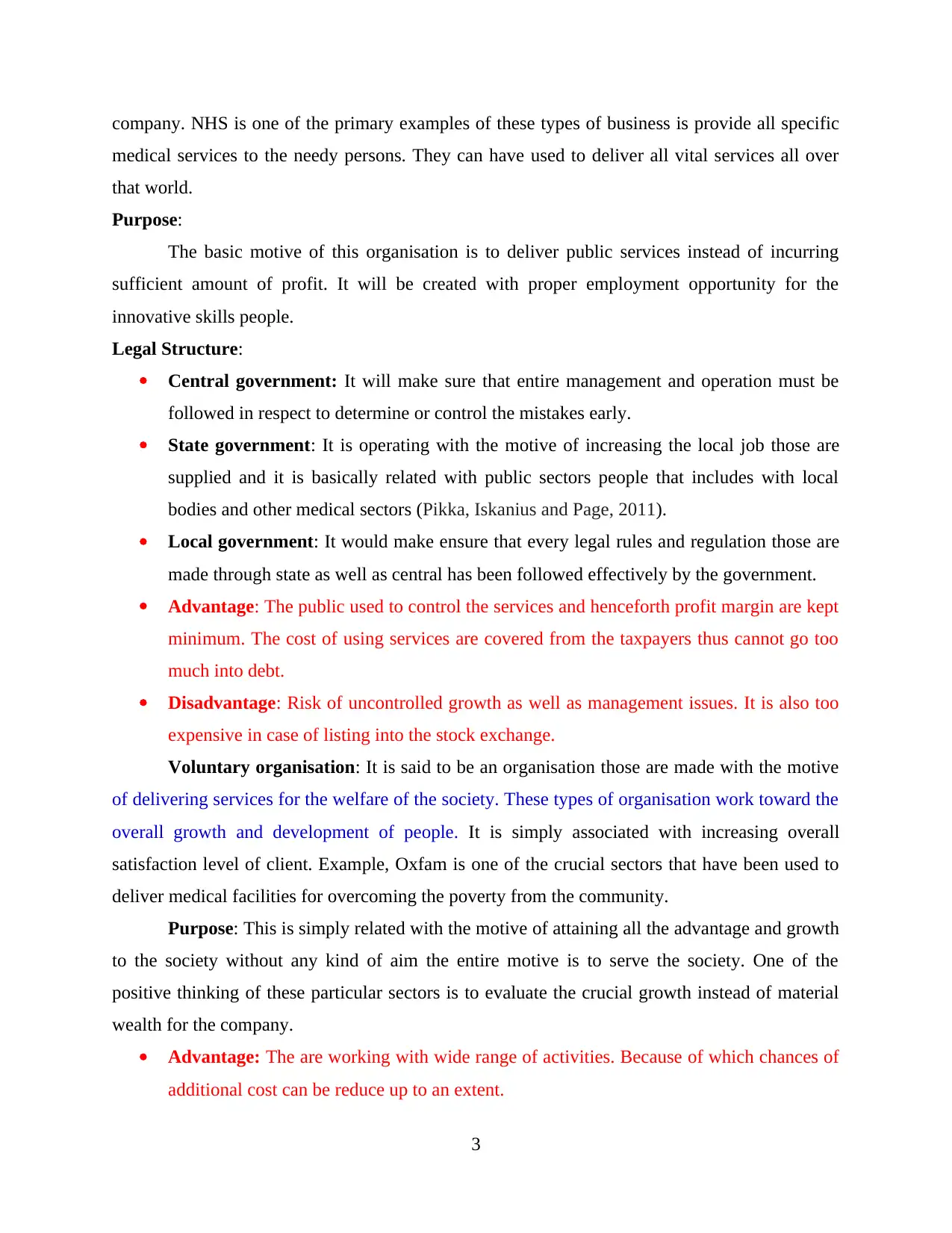
company. NHS is one of the primary examples of these types of business is provide all specific
medical services to the needy persons. They can have used to deliver all vital services all over
that world.
Purpose:
The basic motive of this organisation is to deliver public services instead of incurring
sufficient amount of profit. It will be created with proper employment opportunity for the
innovative skills people.
Legal Structure:
Central government: It will make sure that entire management and operation must be
followed in respect to determine or control the mistakes early.
State government: It is operating with the motive of increasing the local job those are
supplied and it is basically related with public sectors people that includes with local
bodies and other medical sectors (Pikka, Iskanius and Page, 2011).
Local government: It would make ensure that every legal rules and regulation those are
made through state as well as central has been followed effectively by the government.
Advantage: The public used to control the services and henceforth profit margin are kept
minimum. The cost of using services are covered from the taxpayers thus cannot go too
much into debt.
Disadvantage: Risk of uncontrolled growth as well as management issues. It is also too
expensive in case of listing into the stock exchange.
Voluntary organisation: It is said to be an organisation those are made with the motive
of delivering services for the welfare of the society. These types of organisation work toward the
overall growth and development of people. It is simply associated with increasing overall
satisfaction level of client. Example, Oxfam is one of the crucial sectors that have been used to
deliver medical facilities for overcoming the poverty from the community.
Purpose: This is simply related with the motive of attaining all the advantage and growth
to the society without any kind of aim the entire motive is to serve the society. One of the
positive thinking of these particular sectors is to evaluate the crucial growth instead of material
wealth for the company.
Advantage: The are working with wide range of activities. Because of which chances of
additional cost can be reduce up to an extent.
3
medical services to the needy persons. They can have used to deliver all vital services all over
that world.
Purpose:
The basic motive of this organisation is to deliver public services instead of incurring
sufficient amount of profit. It will be created with proper employment opportunity for the
innovative skills people.
Legal Structure:
Central government: It will make sure that entire management and operation must be
followed in respect to determine or control the mistakes early.
State government: It is operating with the motive of increasing the local job those are
supplied and it is basically related with public sectors people that includes with local
bodies and other medical sectors (Pikka, Iskanius and Page, 2011).
Local government: It would make ensure that every legal rules and regulation those are
made through state as well as central has been followed effectively by the government.
Advantage: The public used to control the services and henceforth profit margin are kept
minimum. The cost of using services are covered from the taxpayers thus cannot go too
much into debt.
Disadvantage: Risk of uncontrolled growth as well as management issues. It is also too
expensive in case of listing into the stock exchange.
Voluntary organisation: It is said to be an organisation those are made with the motive
of delivering services for the welfare of the society. These types of organisation work toward the
overall growth and development of people. It is simply associated with increasing overall
satisfaction level of client. Example, Oxfam is one of the crucial sectors that have been used to
deliver medical facilities for overcoming the poverty from the community.
Purpose: This is simply related with the motive of attaining all the advantage and growth
to the society without any kind of aim the entire motive is to serve the society. One of the
positive thinking of these particular sectors is to evaluate the crucial growth instead of material
wealth for the company.
Advantage: The are working with wide range of activities. Because of which chances of
additional cost can be reduce up to an extent.
3
⊘ This is a preview!⊘
Do you want full access?
Subscribe today to unlock all pages.

Trusted by 1+ million students worldwide
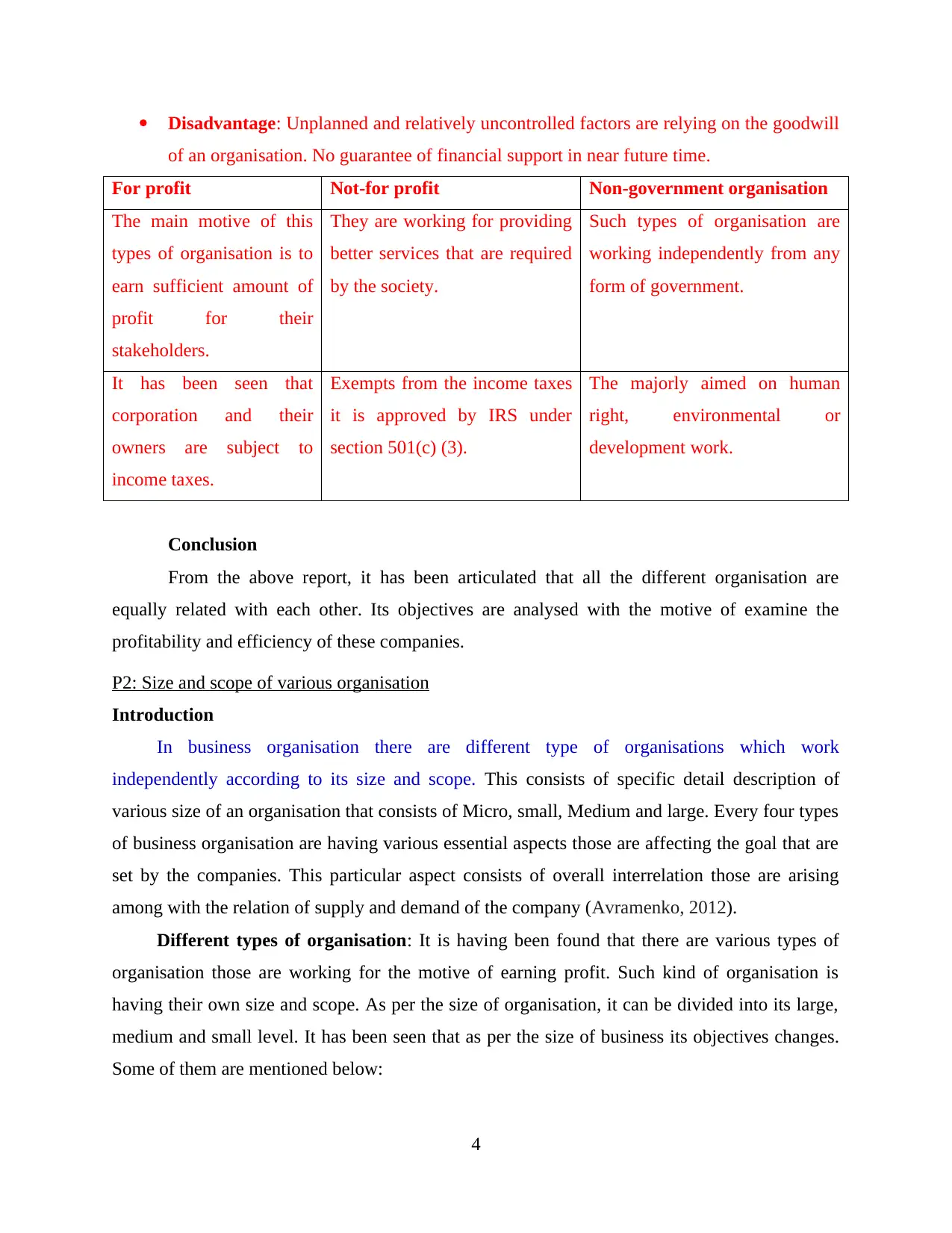
Disadvantage: Unplanned and relatively uncontrolled factors are relying on the goodwill
of an organisation. No guarantee of financial support in near future time.
For profit Not-for profit Non-government organisation
The main motive of this
types of organisation is to
earn sufficient amount of
profit for their
stakeholders.
They are working for providing
better services that are required
by the society.
Such types of organisation are
working independently from any
form of government.
It has been seen that
corporation and their
owners are subject to
income taxes.
Exempts from the income taxes
it is approved by IRS under
section 501(c) (3).
The majorly aimed on human
right, environmental or
development work.
Conclusion
From the above report, it has been articulated that all the different organisation are
equally related with each other. Its objectives are analysed with the motive of examine the
profitability and efficiency of these companies.
P2: Size and scope of various organisation
Introduction
In business organisation there are different type of organisations which work
independently according to its size and scope. This consists of specific detail description of
various size of an organisation that consists of Micro, small, Medium and large. Every four types
of business organisation are having various essential aspects those are affecting the goal that are
set by the companies. This particular aspect consists of overall interrelation those are arising
among with the relation of supply and demand of the company (Avramenko, 2012).
Different types of organisation: It is having been found that there are various types of
organisation those are working for the motive of earning profit. Such kind of organisation is
having their own size and scope. As per the size of organisation, it can be divided into its large,
medium and small level. It has been seen that as per the size of business its objectives changes.
Some of them are mentioned below:
4
of an organisation. No guarantee of financial support in near future time.
For profit Not-for profit Non-government organisation
The main motive of this
types of organisation is to
earn sufficient amount of
profit for their
stakeholders.
They are working for providing
better services that are required
by the society.
Such types of organisation are
working independently from any
form of government.
It has been seen that
corporation and their
owners are subject to
income taxes.
Exempts from the income taxes
it is approved by IRS under
section 501(c) (3).
The majorly aimed on human
right, environmental or
development work.
Conclusion
From the above report, it has been articulated that all the different organisation are
equally related with each other. Its objectives are analysed with the motive of examine the
profitability and efficiency of these companies.
P2: Size and scope of various organisation
Introduction
In business organisation there are different type of organisations which work
independently according to its size and scope. This consists of specific detail description of
various size of an organisation that consists of Micro, small, Medium and large. Every four types
of business organisation are having various essential aspects those are affecting the goal that are
set by the companies. This particular aspect consists of overall interrelation those are arising
among with the relation of supply and demand of the company (Avramenko, 2012).
Different types of organisation: It is having been found that there are various types of
organisation those are working for the motive of earning profit. Such kind of organisation is
having their own size and scope. As per the size of organisation, it can be divided into its large,
medium and small level. It has been seen that as per the size of business its objectives changes.
Some of them are mentioned below:
4
Paraphrase This Document
Need a fresh take? Get an instant paraphrase of this document with our AI Paraphraser
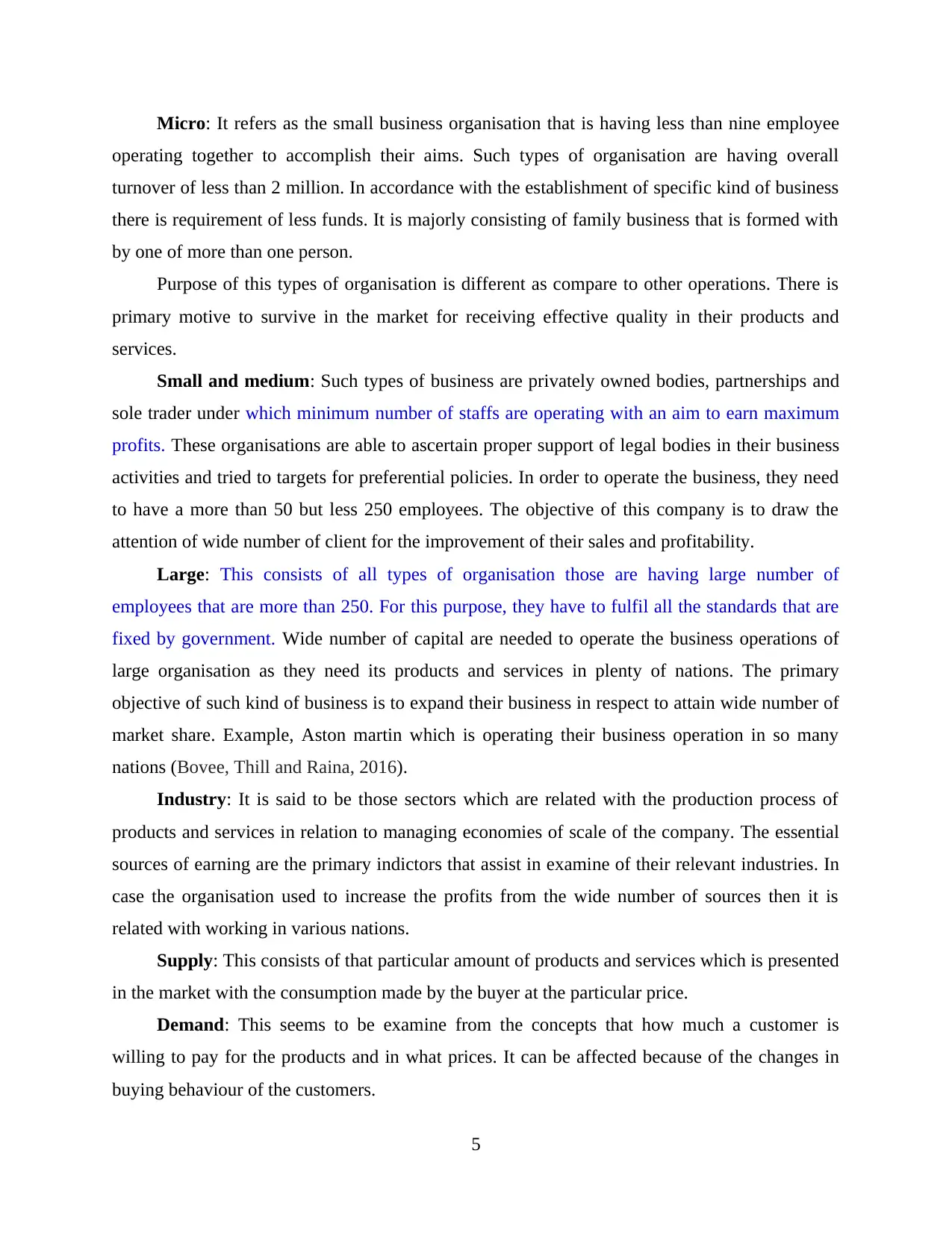
Micro: It refers as the small business organisation that is having less than nine employee
operating together to accomplish their aims. Such types of organisation are having overall
turnover of less than 2 million. In accordance with the establishment of specific kind of business
there is requirement of less funds. It is majorly consisting of family business that is formed with
by one of more than one person.
Purpose of this types of organisation is different as compare to other operations. There is
primary motive to survive in the market for receiving effective quality in their products and
services.
Small and medium: Such types of business are privately owned bodies, partnerships and
sole trader under which minimum number of staffs are operating with an aim to earn maximum
profits. These organisations are able to ascertain proper support of legal bodies in their business
activities and tried to targets for preferential policies. In order to operate the business, they need
to have a more than 50 but less 250 employees. The objective of this company is to draw the
attention of wide number of client for the improvement of their sales and profitability.
Large: This consists of all types of organisation those are having large number of
employees that are more than 250. For this purpose, they have to fulfil all the standards that are
fixed by government. Wide number of capital are needed to operate the business operations of
large organisation as they need its products and services in plenty of nations. The primary
objective of such kind of business is to expand their business in respect to attain wide number of
market share. Example, Aston martin which is operating their business operation in so many
nations (Bovee, Thill and Raina, 2016).
Industry: It is said to be those sectors which are related with the production process of
products and services in relation to managing economies of scale of the company. The essential
sources of earning are the primary indictors that assist in examine of their relevant industries. In
case the organisation used to increase the profits from the wide number of sources then it is
related with working in various nations.
Supply: This consists of that particular amount of products and services which is presented
in the market with the consumption made by the buyer at the particular price.
Demand: This seems to be examine from the concepts that how much a customer is
willing to pay for the products and in what prices. It can be affected because of the changes in
buying behaviour of the customers.
5
operating together to accomplish their aims. Such types of organisation are having overall
turnover of less than 2 million. In accordance with the establishment of specific kind of business
there is requirement of less funds. It is majorly consisting of family business that is formed with
by one of more than one person.
Purpose of this types of organisation is different as compare to other operations. There is
primary motive to survive in the market for receiving effective quality in their products and
services.
Small and medium: Such types of business are privately owned bodies, partnerships and
sole trader under which minimum number of staffs are operating with an aim to earn maximum
profits. These organisations are able to ascertain proper support of legal bodies in their business
activities and tried to targets for preferential policies. In order to operate the business, they need
to have a more than 50 but less 250 employees. The objective of this company is to draw the
attention of wide number of client for the improvement of their sales and profitability.
Large: This consists of all types of organisation those are having large number of
employees that are more than 250. For this purpose, they have to fulfil all the standards that are
fixed by government. Wide number of capital are needed to operate the business operations of
large organisation as they need its products and services in plenty of nations. The primary
objective of such kind of business is to expand their business in respect to attain wide number of
market share. Example, Aston martin which is operating their business operation in so many
nations (Bovee, Thill and Raina, 2016).
Industry: It is said to be those sectors which are related with the production process of
products and services in relation to managing economies of scale of the company. The essential
sources of earning are the primary indictors that assist in examine of their relevant industries. In
case the organisation used to increase the profits from the wide number of sources then it is
related with working in various nations.
Supply: This consists of that particular amount of products and services which is presented
in the market with the consumption made by the buyer at the particular price.
Demand: This seems to be examine from the concepts that how much a customer is
willing to pay for the products and in what prices. It can be affected because of the changes in
buying behaviour of the customers.
5
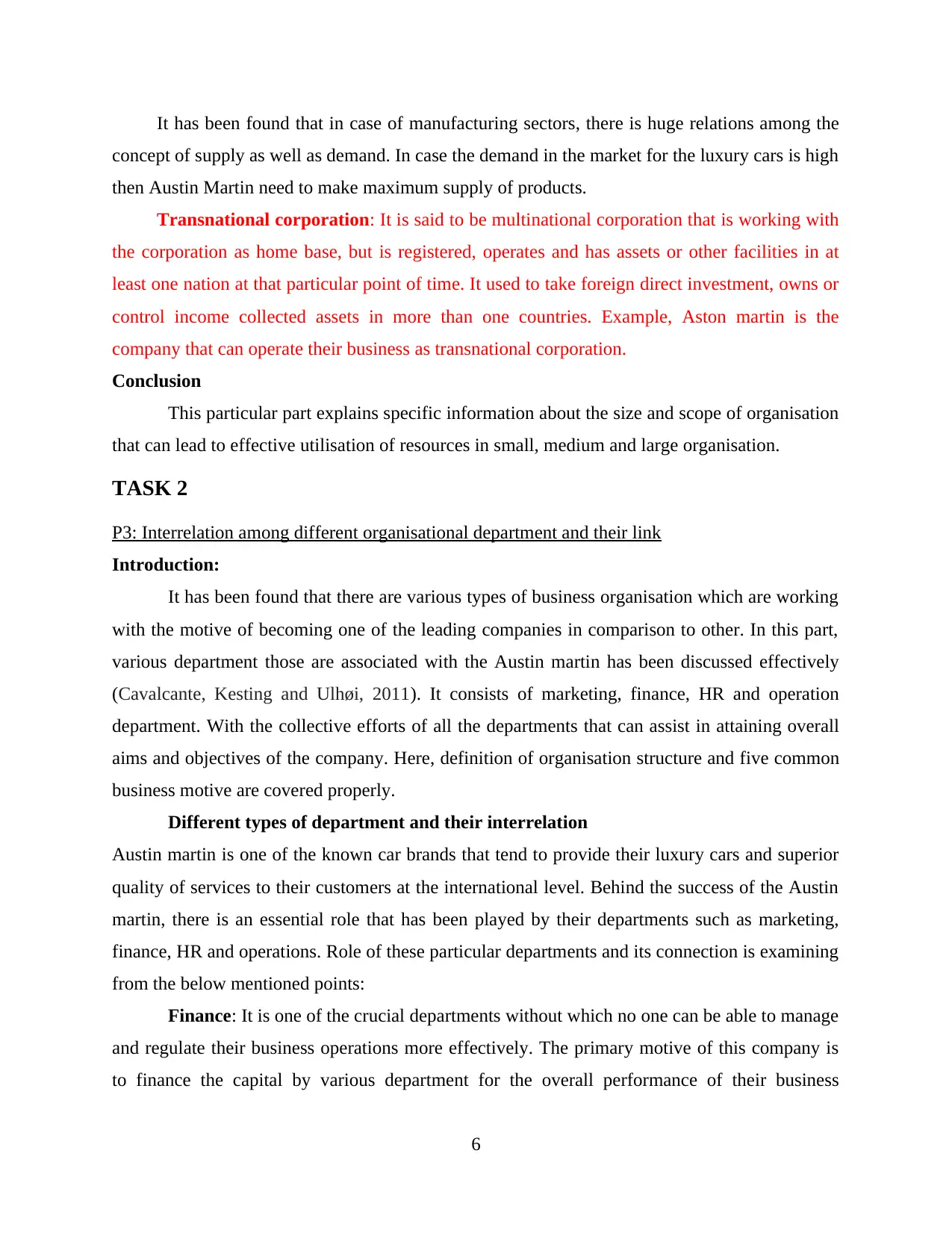
It has been found that in case of manufacturing sectors, there is huge relations among the
concept of supply as well as demand. In case the demand in the market for the luxury cars is high
then Austin Martin need to make maximum supply of products.
Transnational corporation: It is said to be multinational corporation that is working with
the corporation as home base, but is registered, operates and has assets or other facilities in at
least one nation at that particular point of time. It used to take foreign direct investment, owns or
control income collected assets in more than one countries. Example, Aston martin is the
company that can operate their business as transnational corporation.
Conclusion
This particular part explains specific information about the size and scope of organisation
that can lead to effective utilisation of resources in small, medium and large organisation.
TASK 2
P3: Interrelation among different organisational department and their link
Introduction:
It has been found that there are various types of business organisation which are working
with the motive of becoming one of the leading companies in comparison to other. In this part,
various department those are associated with the Austin martin has been discussed effectively
(Cavalcante, Kesting and Ulhøi, 2011). It consists of marketing, finance, HR and operation
department. With the collective efforts of all the departments that can assist in attaining overall
aims and objectives of the company. Here, definition of organisation structure and five common
business motive are covered properly.
Different types of department and their interrelation
Austin martin is one of the known car brands that tend to provide their luxury cars and superior
quality of services to their customers at the international level. Behind the success of the Austin
martin, there is an essential role that has been played by their departments such as marketing,
finance, HR and operations. Role of these particular departments and its connection is examining
from the below mentioned points:
Finance: It is one of the crucial departments without which no one can be able to manage
and regulate their business operations more effectively. The primary motive of this company is
to finance the capital by various department for the overall performance of their business
6
concept of supply as well as demand. In case the demand in the market for the luxury cars is high
then Austin Martin need to make maximum supply of products.
Transnational corporation: It is said to be multinational corporation that is working with
the corporation as home base, but is registered, operates and has assets or other facilities in at
least one nation at that particular point of time. It used to take foreign direct investment, owns or
control income collected assets in more than one countries. Example, Aston martin is the
company that can operate their business as transnational corporation.
Conclusion
This particular part explains specific information about the size and scope of organisation
that can lead to effective utilisation of resources in small, medium and large organisation.
TASK 2
P3: Interrelation among different organisational department and their link
Introduction:
It has been found that there are various types of business organisation which are working
with the motive of becoming one of the leading companies in comparison to other. In this part,
various department those are associated with the Austin martin has been discussed effectively
(Cavalcante, Kesting and Ulhøi, 2011). It consists of marketing, finance, HR and operation
department. With the collective efforts of all the departments that can assist in attaining overall
aims and objectives of the company. Here, definition of organisation structure and five common
business motive are covered properly.
Different types of department and their interrelation
Austin martin is one of the known car brands that tend to provide their luxury cars and superior
quality of services to their customers at the international level. Behind the success of the Austin
martin, there is an essential role that has been played by their departments such as marketing,
finance, HR and operations. Role of these particular departments and its connection is examining
from the below mentioned points:
Finance: It is one of the crucial departments without which no one can be able to manage
and regulate their business operations more effectively. The primary motive of this company is
to finance the capital by various department for the overall performance of their business
6
⊘ This is a preview!⊘
Do you want full access?
Subscribe today to unlock all pages.

Trusted by 1+ million students worldwide
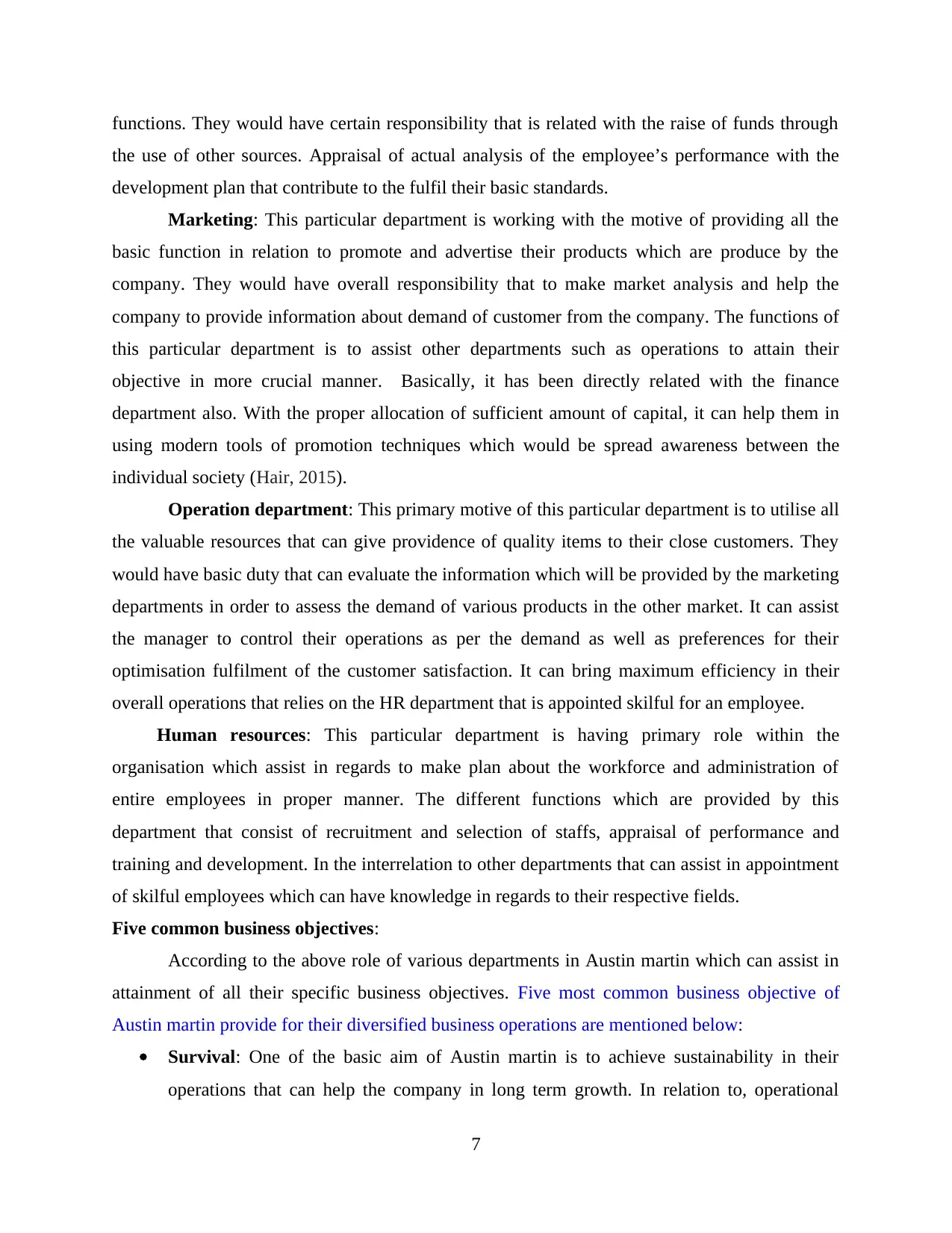
functions. They would have certain responsibility that is related with the raise of funds through
the use of other sources. Appraisal of actual analysis of the employee’s performance with the
development plan that contribute to the fulfil their basic standards.
Marketing: This particular department is working with the motive of providing all the
basic function in relation to promote and advertise their products which are produce by the
company. They would have overall responsibility that to make market analysis and help the
company to provide information about demand of customer from the company. The functions of
this particular department is to assist other departments such as operations to attain their
objective in more crucial manner. Basically, it has been directly related with the finance
department also. With the proper allocation of sufficient amount of capital, it can help them in
using modern tools of promotion techniques which would be spread awareness between the
individual society (Hair, 2015).
Operation department: This primary motive of this particular department is to utilise all
the valuable resources that can give providence of quality items to their close customers. They
would have basic duty that can evaluate the information which will be provided by the marketing
departments in order to assess the demand of various products in the other market. It can assist
the manager to control their operations as per the demand as well as preferences for their
optimisation fulfilment of the customer satisfaction. It can bring maximum efficiency in their
overall operations that relies on the HR department that is appointed skilful for an employee.
Human resources: This particular department is having primary role within the
organisation which assist in regards to make plan about the workforce and administration of
entire employees in proper manner. The different functions which are provided by this
department that consist of recruitment and selection of staffs, appraisal of performance and
training and development. In the interrelation to other departments that can assist in appointment
of skilful employees which can have knowledge in regards to their respective fields.
Five common business objectives:
According to the above role of various departments in Austin martin which can assist in
attainment of all their specific business objectives. Five most common business objective of
Austin martin provide for their diversified business operations are mentioned below:
Survival: One of the basic aim of Austin martin is to achieve sustainability in their
operations that can help the company in long term growth. In relation to, operational
7
the use of other sources. Appraisal of actual analysis of the employee’s performance with the
development plan that contribute to the fulfil their basic standards.
Marketing: This particular department is working with the motive of providing all the
basic function in relation to promote and advertise their products which are produce by the
company. They would have overall responsibility that to make market analysis and help the
company to provide information about demand of customer from the company. The functions of
this particular department is to assist other departments such as operations to attain their
objective in more crucial manner. Basically, it has been directly related with the finance
department also. With the proper allocation of sufficient amount of capital, it can help them in
using modern tools of promotion techniques which would be spread awareness between the
individual society (Hair, 2015).
Operation department: This primary motive of this particular department is to utilise all
the valuable resources that can give providence of quality items to their close customers. They
would have basic duty that can evaluate the information which will be provided by the marketing
departments in order to assess the demand of various products in the other market. It can assist
the manager to control their operations as per the demand as well as preferences for their
optimisation fulfilment of the customer satisfaction. It can bring maximum efficiency in their
overall operations that relies on the HR department that is appointed skilful for an employee.
Human resources: This particular department is having primary role within the
organisation which assist in regards to make plan about the workforce and administration of
entire employees in proper manner. The different functions which are provided by this
department that consist of recruitment and selection of staffs, appraisal of performance and
training and development. In the interrelation to other departments that can assist in appointment
of skilful employees which can have knowledge in regards to their respective fields.
Five common business objectives:
According to the above role of various departments in Austin martin which can assist in
attainment of all their specific business objectives. Five most common business objective of
Austin martin provide for their diversified business operations are mentioned below:
Survival: One of the basic aim of Austin martin is to achieve sustainability in their
operations that can help the company in long term growth. In relation to, operational
7
Paraphrase This Document
Need a fresh take? Get an instant paraphrase of this document with our AI Paraphraser
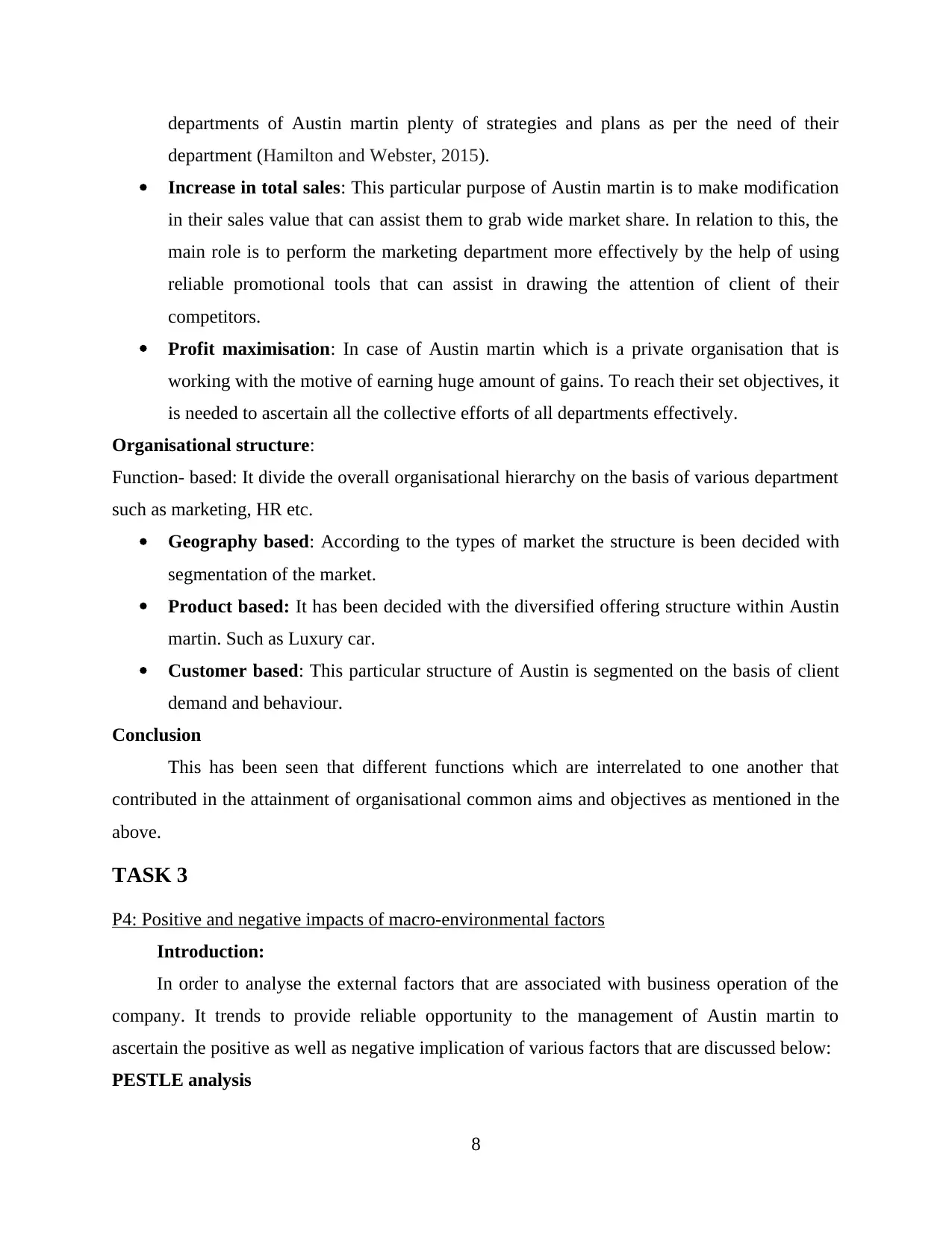
departments of Austin martin plenty of strategies and plans as per the need of their
department (Hamilton and Webster, 2015).
Increase in total sales: This particular purpose of Austin martin is to make modification
in their sales value that can assist them to grab wide market share. In relation to this, the
main role is to perform the marketing department more effectively by the help of using
reliable promotional tools that can assist in drawing the attention of client of their
competitors.
Profit maximisation: In case of Austin martin which is a private organisation that is
working with the motive of earning huge amount of gains. To reach their set objectives, it
is needed to ascertain all the collective efforts of all departments effectively.
Organisational structure:
Function- based: It divide the overall organisational hierarchy on the basis of various department
such as marketing, HR etc.
Geography based: According to the types of market the structure is been decided with
segmentation of the market.
Product based: It has been decided with the diversified offering structure within Austin
martin. Such as Luxury car.
Customer based: This particular structure of Austin is segmented on the basis of client
demand and behaviour.
Conclusion
This has been seen that different functions which are interrelated to one another that
contributed in the attainment of organisational common aims and objectives as mentioned in the
above.
TASK 3
P4: Positive and negative impacts of macro-environmental factors
Introduction:
In order to analyse the external factors that are associated with business operation of the
company. It trends to provide reliable opportunity to the management of Austin martin to
ascertain the positive as well as negative implication of various factors that are discussed below:
PESTLE analysis
8
department (Hamilton and Webster, 2015).
Increase in total sales: This particular purpose of Austin martin is to make modification
in their sales value that can assist them to grab wide market share. In relation to this, the
main role is to perform the marketing department more effectively by the help of using
reliable promotional tools that can assist in drawing the attention of client of their
competitors.
Profit maximisation: In case of Austin martin which is a private organisation that is
working with the motive of earning huge amount of gains. To reach their set objectives, it
is needed to ascertain all the collective efforts of all departments effectively.
Organisational structure:
Function- based: It divide the overall organisational hierarchy on the basis of various department
such as marketing, HR etc.
Geography based: According to the types of market the structure is been decided with
segmentation of the market.
Product based: It has been decided with the diversified offering structure within Austin
martin. Such as Luxury car.
Customer based: This particular structure of Austin is segmented on the basis of client
demand and behaviour.
Conclusion
This has been seen that different functions which are interrelated to one another that
contributed in the attainment of organisational common aims and objectives as mentioned in the
above.
TASK 3
P4: Positive and negative impacts of macro-environmental factors
Introduction:
In order to analyse the external factors that are associated with business operation of the
company. It trends to provide reliable opportunity to the management of Austin martin to
ascertain the positive as well as negative implication of various factors that are discussed below:
PESTLE analysis
8
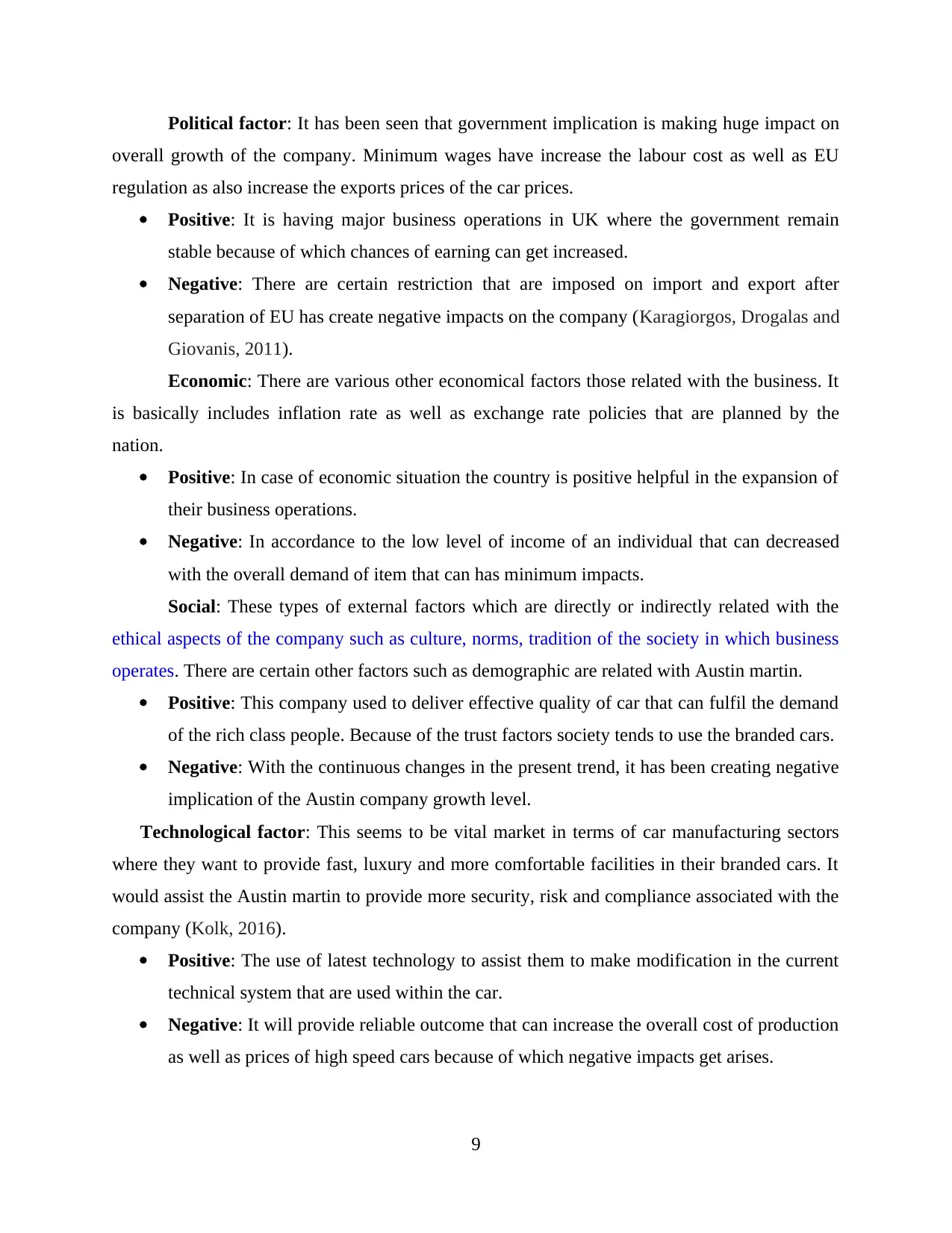
Political factor: It has been seen that government implication is making huge impact on
overall growth of the company. Minimum wages have increase the labour cost as well as EU
regulation as also increase the exports prices of the car prices.
Positive: It is having major business operations in UK where the government remain
stable because of which chances of earning can get increased.
Negative: There are certain restriction that are imposed on import and export after
separation of EU has create negative impacts on the company (Karagiorgos, Drogalas and
Giovanis, 2011).
Economic: There are various other economical factors those related with the business. It
is basically includes inflation rate as well as exchange rate policies that are planned by the
nation.
Positive: In case of economic situation the country is positive helpful in the expansion of
their business operations.
Negative: In accordance to the low level of income of an individual that can decreased
with the overall demand of item that can has minimum impacts.
Social: These types of external factors which are directly or indirectly related with the
ethical aspects of the company such as culture, norms, tradition of the society in which business
operates. There are certain other factors such as demographic are related with Austin martin.
Positive: This company used to deliver effective quality of car that can fulfil the demand
of the rich class people. Because of the trust factors society tends to use the branded cars.
Negative: With the continuous changes in the present trend, it has been creating negative
implication of the Austin company growth level.
Technological factor: This seems to be vital market in terms of car manufacturing sectors
where they want to provide fast, luxury and more comfortable facilities in their branded cars. It
would assist the Austin martin to provide more security, risk and compliance associated with the
company (Kolk, 2016).
Positive: The use of latest technology to assist them to make modification in the current
technical system that are used within the car.
Negative: It will provide reliable outcome that can increase the overall cost of production
as well as prices of high speed cars because of which negative impacts get arises.
9
overall growth of the company. Minimum wages have increase the labour cost as well as EU
regulation as also increase the exports prices of the car prices.
Positive: It is having major business operations in UK where the government remain
stable because of which chances of earning can get increased.
Negative: There are certain restriction that are imposed on import and export after
separation of EU has create negative impacts on the company (Karagiorgos, Drogalas and
Giovanis, 2011).
Economic: There are various other economical factors those related with the business. It
is basically includes inflation rate as well as exchange rate policies that are planned by the
nation.
Positive: In case of economic situation the country is positive helpful in the expansion of
their business operations.
Negative: In accordance to the low level of income of an individual that can decreased
with the overall demand of item that can has minimum impacts.
Social: These types of external factors which are directly or indirectly related with the
ethical aspects of the company such as culture, norms, tradition of the society in which business
operates. There are certain other factors such as demographic are related with Austin martin.
Positive: This company used to deliver effective quality of car that can fulfil the demand
of the rich class people. Because of the trust factors society tends to use the branded cars.
Negative: With the continuous changes in the present trend, it has been creating negative
implication of the Austin company growth level.
Technological factor: This seems to be vital market in terms of car manufacturing sectors
where they want to provide fast, luxury and more comfortable facilities in their branded cars. It
would assist the Austin martin to provide more security, risk and compliance associated with the
company (Kolk, 2016).
Positive: The use of latest technology to assist them to make modification in the current
technical system that are used within the car.
Negative: It will provide reliable outcome that can increase the overall cost of production
as well as prices of high speed cars because of which negative impacts get arises.
9
⊘ This is a preview!⊘
Do you want full access?
Subscribe today to unlock all pages.

Trusted by 1+ million students worldwide
1 out of 16
Related Documents
Your All-in-One AI-Powered Toolkit for Academic Success.
+13062052269
info@desklib.com
Available 24*7 on WhatsApp / Email
![[object Object]](/_next/static/media/star-bottom.7253800d.svg)
Unlock your academic potential
Copyright © 2020–2025 A2Z Services. All Rights Reserved. Developed and managed by ZUCOL.





